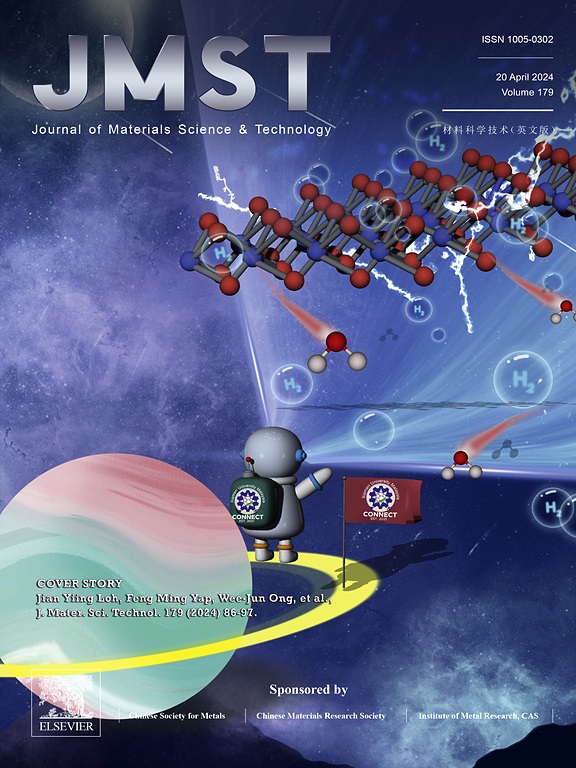具有高温阻燃性和机械可靠性的连续聚酰亚胺纤维增强陶瓷基复合材料
IF 14.3
1区 材料科学
Q1 MATERIALS SCIENCE, MULTIDISCIPLINARY
引用次数: 0
摘要
聚酰亚胺纤维(PIf)基织物由于其高比强度和环境稳定性被广泛用于航空航天和汽车应用的聚合物基复合材料。然而,聚合物基体的阻燃性和高温力学性能不足,限制了其在火灾易发环境中的性能。为了满足阻燃性和机械可靠性的要求,本文采用ZnO陶瓷代替聚合物基体,采用冷烧结工艺制备连续PIf增强陶瓷基复合材料。首先采用硅烷偶联剂对ZnO粉体进行表面改性,优化了粉体的分散性,提高了ZnO陶瓷的抗弯强度。浆料浸渍后,ZnO粉末填充的3D PIf毡在低至220℃的低温烧结下致密化。虽然陶瓷基体为复合材料提供了优异的阻燃性,但聚合物纤维提高了耐热冲击性,这两种材料共同使复合材料在1000°C火焰下保持结构完整性。此外,复合材料表现出优异的机械可靠性和强度,威布尔模量为13.7,在80%断裂应力下10,000次疲劳循环后仍能保持初始强度。随机PIf织物结构提供的有效载荷分布,以及PIf的高断裂伸长率,即使在冲击损伤下,也能在裂纹扩展过程中吸收大量能量。这种新型陶瓷基复合材料拓展了高性能聚合物纤维的应用潜力,并为开发轻质、阻燃和机械坚固的材料奠定了基础。本文章由计算机程序翻译,如有差异,请以英文原文为准。

Continuous polyimide fiber reinforced ceramic matrix composites with high-temperature flame retardancy and mechanical reliability
Polyimide fiber (PIf) based fabric is widely used as a reinforcement in polymer matrix composites for aerospace and automotive applications due to its high specific strength and environmental stability. However, the inadequate flame resistance and high-temperature mechanical properties of polymer matrices limit their performance in fire-prone environments. To address the demand for flame retardancy and mechanical reliability, here we employ ZnO ceramic instead of polymer matrix to prepare continuous PIf reinforced ceramic matrix composites by using the cold sintering process. The dispersibility of ZnO powder is first optimized by surface modification with a silane coupling agent, which also enhances the flexural strength of cold-sintered ZnO ceramic. After slurry impregnation, the ZnO powder-filled 3D PIf felt is then densified by cold sintering at a temperature as low as 220°C. While the ceramic matrix provides the composite with excellent flame retardancy, the polymer fiber improves the thermal shock resistance, which together allow the composite to maintain structural integrity against a 1000°C flame. Moreover, the composite exhibits extraordinary mechanical reliability and strength with a Weibull modulus of 13.7 and retention of initial strength after 10,000 fatigue cycles at 80% of fracture stress. The effective load distribution provided by the random PIf fabric structure, along with the high elongation at break of the PIf, enables significant energy absorption during crack propagation even under impact damage. This novel ceramic matrix composite expands the application potential of superior performance polymer fibers and establishes a foundation for the development of lightweight, flame-retardant, and mechanically robust materials.
求助全文
通过发布文献求助,成功后即可免费获取论文全文。
去求助
来源期刊

Journal of Materials Science & Technology
工程技术-材料科学:综合
CiteScore
20.00
自引率
11.00%
发文量
995
审稿时长
13 days
期刊介绍:
Journal of Materials Science & Technology strives to promote global collaboration in the field of materials science and technology. It primarily publishes original research papers, invited review articles, letters, research notes, and summaries of scientific achievements. The journal covers a wide range of materials science and technology topics, including metallic materials, inorganic nonmetallic materials, and composite materials.
 求助内容:
求助内容: 应助结果提醒方式:
应助结果提醒方式:


